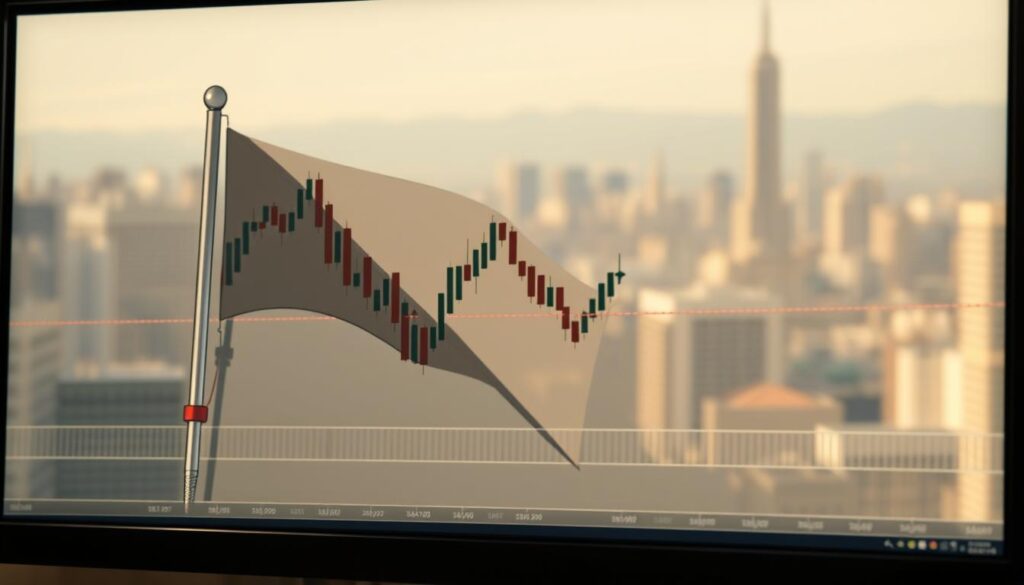The cryptocurrency market is seeing big changes. Institutional investors are betting big on $1.95 billion worth of BTC. Galaxy Digital, a key player, has increased its BTC to 17,102 after making a profit in Q2. The Bitcoin price prediction is getting tricky with Trump’s executive order affecting the market. A bear flag pattern is forming below $115K. Investors are watching the market closely.
The market recently dropped 0.43% below $115K. But, the overall market is staying strong.
Key Takeaways
- Institutional investors like Galaxy Digital are boosting their BTC holdings.
- Trump’s executive order is influencing the cryptocurrency market trends.
- A bear flag pattern is emerging below $115K.
- The market dipped 0.43% below $115K.
- Institutional bets like the $1.95B BTC bet are significant.
Current Bitcoin Price and Market Status
As of the latest update, Bitcoin is quoted at $113,906. This shows its strong market presence. This price is key to understanding the market’s current state.
Latest Price Movements and Trading Volume
Bitcoin’s price has been changing, with a 24-hour trading volume near $58.5 billion. This high trading activity shows a lot of market interest.
Such a large trading volume means investors are very active. They are likely watching for future price changes.
Market Capitalization and Dominance Metrics
To grasp Bitcoin’s market status, we need to look at its market capitalization and dominance. The exact market capitalization isn’t given, but Bitcoin’s dominance is a key indicator of its strength.
Key Support and Resistance Levels
Bitcoin has key support levels at $112,178, $110,663, and $109,060. Resistance levels are at $116,912 and $118,878. Knowing these levels helps investors make better choices.
| Category | Value | Description |
|---|---|---|
| Current Price | $113,906 | Bitcoin’s current market price |
| 24-hour Trading Volume | $58.5 billion | Trading activity in the last 24 hours |
| Support Levels | $112,178, $110,663, $109,060 | Key support price levels |
| Resistance Levels | $116,912, $118,878 | Key resistance price levels |
The $1.95 Billion Bitcoin Bet: Market Implications
Galaxy Digital’s recent financial reports show a big $1.95 billion Bitcoin position. This has raised many questions about its impact.
Origin and Structure of the Massive BTC Position
The $1.95 billion Bitcoin bet comes from Galaxy Digital’s Q2 profit of $30.7 million. This profit boosted its Bitcoin holdings to 17,102 BTC.
This big investment shows that institutional players are really believing in Bitcoin’s future.
Institutional Players Behind the Investment
Galaxy Digital isn’t the only one betting big on Bitcoin. Other big players are also putting a lot of money into Bitcoin. This shows a bigger trend.
Historical Context of Similar-Sized Bets
Big investments in Bitcoin have had big effects on the market before.
Previous Market Reactions
Big bets on Bitcoin have sometimes caused big price changes.
Outcome Analysis of Past Large Positions
Looking at how past big bets did can help us guess what this $1.95 billion bet might do.
| Year | Investment Size | Market Reaction |
|---|---|---|
| 2017 | $1B | Price surge |
| 2020 | $500M | Stable market |
| 2023 | $1.95B | ? |
Trump’s Executive Order: Cryptocurrency Policy Shift
During his time in office, former President Trump made comments and issued executive orders that stressed the need to be careful with cryptocurrencies. His policy put a lot of emphasis on customer protection, regulatory oversight, and fighting money laundering (AML). This was a sign that cryptocurrencies shouldn’t hurt the dominance of the U.S. dollar. The goal of the guidelines was to lower the risks that come with digital assets while still letting new ideas come up within strict rules. This was a step toward the government getting more involved in the cryptocurrency markets in an organized way. It affected U.S.-based exchanges, stablecoins, and DeFi projects.
Technical Analysis: Understanding the Bear Flag Below $115K
A bear flag is forming in Bitcoin’s price chart, hinting at a possible downtrend continuation. This pattern shows a sharp drop followed by a consolidation phase. It usually leads to a further drop in price.
Formation and Characteristics of the Pattern
The bear flag pattern starts with a big price drop, then a consolidation phase. During this phase, the price stays in a narrow range. This is often seen with decreasing volume, showing buyers are losing confidence.
Key characteristics of the bear flag include:
- A sharp price decline (flagpole)
- A consolidation phase (flag) with a slight upward or sideways trend
- Decreasing volume during the consolidation phase
Volume Profile During Pattern Development
Looking at the volume during the bear flag’s development is key. Volume usually goes down as the flag forms, showing less interest from investors. A big volume spike when the price breaks down can confirm the bearish trend.

Potential Price Targets Based on Pattern Measurements
To guess price targets, analysts measure the flagpole’s height and project it downward from the breakdown point. This method gives a clear estimate of the possible drop.
Downside Scenarios
If the bear flag pattern unfolds as expected, Bitcoin’s price might hit the projected target. The table below shows possible downside scenarios based on different breakdown levels.
| Breakdown Level | Projected Target |
|---|---|
| $105,000 | $95,000 |
| $100,000 | $90,000 |
Invalidation Levels
The bear flag pattern is no longer valid if Bitcoin’s price goes above the flag’s upper trend line. This could mean the downtrend is reversing.
Key invalidation levels to watch:
- A move above $115,000
- Sustained trading above the 50-period EMA
Bitcoin Price Prediction Models: Quantitative Approaches
Trying to predict Bitcoin’s price is tough. But, quantitative models try to make it easier. They help us understand Bitcoin’s price cycle and where it might go next.
Stock-to-Flow Model Updated Projections
The stock-to-flow model is popular among Bitcoin fans. It bases its forecast on how rare Bitcoin is. Recent updates say Bitcoin’s price might hit new highs soon. Key stats from the model include:
- Predicted price targets based on the model’s scarcity metric
- Historical accuracy of the model in predicting Bitcoin’s price
MVRV Z-Score and Market Cycle Position
The MVRV Z-score is key for understanding Bitcoin’s market cycle. It shows how Bitcoin’s market value compares to its realized value. Insights from the MVRV Z-score include:
- Identification of overvalued and undervalued market conditions
- Historical correlation with Bitcoin’s price movements
AI-Based Prediction Systems and Their Accuracy
AI systems are now used to guess Bitcoin’s price. They look at lots of data to spot patterns and predict prices. The accuracy of these systems is getting better, with some showing great results.
Looking at these models helps investors and analysts understand Bitcoin’s possible price path. This knowledge can guide their decisions.
Institutional Investor Positioning and Bitcoin Exposure
Recently, institutional investors have changed how they view Bitcoin. This shift is seen in their investment plans, from how companies manage their money to how hedge funds feel about Bitcoin.
Recent Changes in Corporate Treasury Allocations
Big companies are now adding Bitcoin to their money management plans. For example, Galaxy Digital has bought a lot more Bitcoin, now holding 17,102 BTC. This shows they believe Bitcoin can be a safe place to keep money and protect against inflation.
It’s not just companies focused on crypto. Even traditional businesses are looking at Bitcoin for their money management. They want to spread out their investments and protect against market ups and downs.
ETF Inflows and Outflows Analysis
The Bitcoin ETF market has seen a lot of activity, with more money coming in. Looking at these numbers helps us understand how institutions feel about Bitcoin and what’s happening in the market.
- Bitcoin ETFs have been getting more money, showing that institutions are interested.
- When money goes out, it often happens when the market is shaky or when investors take profits.
Hedge Fund Sentiment Indicators
Hedge funds are also changing how they see Bitcoin. By looking at their positions and talking to managers, we can see how they view Bitcoin in their portfolios.
Some hedge funds are putting more money into Bitcoin, while others are being more careful. This shows how complex it is for institutions to make decisions about crypto.
On-Chain Metrics Signaling Bitcoin Price Direction
On-chain metrics are data points that come straight from the activity on the blockchain. They show Bitcoin’s market trends and possible price changes. Some key signs are:
- Active Addresses: Rising active addresses usually mean that more people are using the network, which could mean that people are feeling optimistic.
- Transaction Volume: More transactions can mean that demand is growing or that institutions are doing more.
- HODL Waves: Keep an eye on how old the coins you hold; holding them for a long time may be a sign of market trust.
- Exchange Flows: The net inflows or exits from exchanges show how much pressure there is to buy or sell.
- Network Fees and Hash Rate: Changes in these can show how miners are behaving and how secure the network is, which can hurt market trust.
Traders and analysts can guess where prices might go by looking at these measures, but they aren’t perfect because they can be affected by outside factors like macroeconomic events or regulatory news.
Macroeconomic Catalysts for Bitcoin Movement
Bitcoin’s price is strongly influenced by broader economic factors, including:
- Monetary Policy: Central bank actions like interest rate changes or quantitative easing can drive demand for Bitcoin as a hedge against inflation.
- Inflation Trends: High inflation often increases investor interest in Bitcoin as a store of value.
- Fiscal Stimulus: Government spending and stimulus packages can indirectly impact crypto investment flows.
- Global Economic Uncertainty: Geopolitical tensions, recessions, or currency devaluations can boost Bitcoin adoption as an alternative asset.
- Regulatory Developments: Announcements regarding crypto regulation or institutional adoption can trigger price swings.
These macroeconomic catalysts interact with market sentiment and on-chain metrics to influence Bitcoin’s short- and long-term price movements.

Expert Bitcoin Price Forecasts and Time Horizons
Experts have different views on Bitcoin’s future price, showing its unpredictable nature. The market keeps changing, leading to a range of predictions. These range from very optimistic to cautious and pessimistic.
Wall Street Analyst Consensus
Wall Street analysts have mixed opinions on Bitcoin. Some think it will hit new highs, thanks to big investors and growing demand. Others fear it could drop due to rules and market ups and downs.
Crypto-Native Research Firm Projections
Research firms focused on crypto offer forecasts based on technical analysis and trends. They often point to big price swings, based on past patterns and new trends.
Contrarian Views and Alternative Scenarios
Some experts suggest different paths, including both positive and negative scenarios. These views are important for understanding the risks and chances in the Bitcoin market.
Bull Case Price Targets
Some predict Bitcoin could hit new highs, with targets over $150,000. This is due to more people using it and big investors getting involved.
Bear Case Risk Assessment
On the other hand, some forecasts warn of a drop to $80,000 or less. They point to risks from rules and market swings as main concerns.
| Forecast Type | Price Target | Driving Factors |
|---|---|---|
| Bullish | $150,000+ | Institutional investment, adoption |
| Bearish | $80,000- | Regulatory risks, market volatility |
Conclusion
Understanding Bitcoin’s price is key for investors and analysts. This article shows how factors like a $1.95 billion bet and Trump’s order affect prices. It also talks about a bear flag pattern below $115K.
Bitcoin’s price changes due to many things. This includes big investments, rules, and technical signs. Tools like the stock-to-flow model and AI predictions help guess prices and market trends.
Investors need to think about these things when planning their strategies. The current market, on-chain data, and big economic events all impact Bitcoin’s price. Keeping up with trends and analysis is vital for smart investing.
By understanding Bitcoin’s price changes, investors can do well in this fast-changing market.
FAQ
What is the current Bitcoin price prediction scenario?
FAQ
What is the current Bitcoin price prediction scenario?
The current Bitcoin price prediction is shaped by a $1.95 billion BTC bet by Galaxy Digital and Trump’s executive order on crypto policy.
How has Trump’s executive order impacted the cryptocurrency market?
Trump’s executive order has changed crypto policy. This has led to changes in trading volumes and statements from industry leaders.
What is the significance of the bear flag pattern below $115K?
The bear flag pattern below $115K is a technical indicator. It suggests possible price targets based on pattern measurements. It also shows downside scenarios and invalidation levels.
What are the quantitative Bitcoin price prediction models?
Quantitative models for Bitcoin price include the stock-to-flow model, MVRV Z-score, and AI-based systems. These models provide updated predictions and accuracy.
How do institutional investors influence Bitcoin’s price?
Institutional investors affect Bitcoin’s price through their actions. This includes changes in corporate treasury allocations, ETF inflows and outflows, and hedge fund sentiment.
What on-chain metrics signal Bitcoin’s price direction?
On-chain metrics that show Bitcoin’s price direction include wallet address growth and distribution, realized cap, miner position index, and hash ribbon signals.
How do macroeconomic catalysts impact Bitcoin’s movement?
Macroeconomic factors that affect Bitcoin’s movement include Federal Reserve policy, global liquidity, geopolitical risk, and regulatory developments worldwide.
What are the expert Bitcoin price forecasts and time horizons?
Expert forecasts for Bitcoin include Wall Street analyst consensus, crypto research firm projections, and alternative scenarios. These forecasts vary by time horizon.
What is the stock-to-flow model, and how does it predict Bitcoin’s price?
The stock-to-flow model predicts Bitcoin’s price based on its scarcity. It provides updated projections for future price movements.
How do ETF inflows and outflows affect Bitcoin’s price?
ETF inflows and outflows can change Bitcoin’s price by affecting demand and supply. Analyzing these flows gives insights into investor sentiment.
.95 billion BTC bet by Galaxy Digital and Trump’s executive order on crypto policy.
How has Trump’s executive order impacted the cryptocurrency market?
Trump’s executive order has changed crypto policy. This has led to changes in trading volumes and statements from industry leaders.
What is the significance of the bear flag pattern below 5K?
The bear flag pattern below 5K is a technical indicator. It suggests possible price targets based on pattern measurements. It also shows downside scenarios and invalidation levels.
What are the quantitative Bitcoin price prediction models?
Quantitative models for Bitcoin price include the stock-to-flow model, MVRV Z-score, and AI-based systems. These models provide updated predictions and accuracy.
How do institutional investors influence Bitcoin’s price?
Institutional investors affect Bitcoin’s price through their actions. This includes changes in corporate treasury allocations, ETF inflows and outflows, and hedge fund sentiment.
What on-chain metrics signal Bitcoin’s price direction?
On-chain metrics that show Bitcoin’s price direction include wallet address growth and distribution, realized cap, miner position index, and hash ribbon signals.
How do macroeconomic catalysts impact Bitcoin’s movement?
Macroeconomic factors that affect Bitcoin’s movement include Federal Reserve policy, global liquidity, geopolitical risk, and regulatory developments worldwide.
What are the expert Bitcoin price forecasts and time horizons?
Expert forecasts for Bitcoin include Wall Street analyst consensus, crypto research firm projections, and alternative scenarios. These forecasts vary by time horizon.
What is the stock-to-flow model, and how does it predict Bitcoin’s price?
The stock-to-flow model predicts Bitcoin’s price based on its scarcity. It provides updated projections for future price movements.
How do ETF inflows and outflows affect Bitcoin’s price?
ETF inflows and outflows can change Bitcoin’s price by affecting demand and supply. Analyzing these flows gives insights into investor sentiment.



